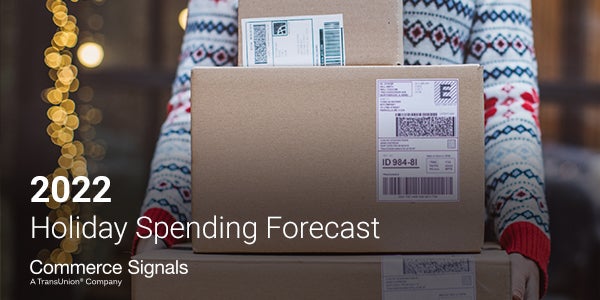It’s no secret the holiday season is a key sales period for retail, travel and many other industries. This season can make or break a business, large or small. But with high inflation and fears of consumers pulling back, there are a lot of unknowns this year.
To help brands prepare, Commerce Signals has produced a Holiday Spending Forecast that predicts consumer behaviors between Thanksgiving and the week of Christmas.
Our forecasting model analyzed permissioned and anonymized consumer spending data across all channels, including sales through both Visa and Mastercard, credit and debit for 40 million households. The model also considered spending trends since 2018 – with more weight given to recent trends – and accounted for consumer price inflation (CPI) as measured by the US Bureau of Labor Statistics.
Now, the results are in: Our consumer spending forecast for the 2022 holiday season is quite positive. We predict total consumer card spending to increase 11% compared to 2021. And during the week of Black Friday, we expect sales will grow 16% compared to 2021, aided by more consumers willing to shop in-store.
Travel is back
The travel industry will soar this holiday season as consumer travel spending will be back to pre-pandemic levels. It’s projected to be the highest growth category in our forecast, increasing by 32% versus last year and 79% versus 2020.
Drilling down into the travel category, airline spending tops our list with projected growth of 50%. Hotel spending is projected to increase 29% as well. Notably, other transportation, which includes ride sharing, is also expected to recover to pre-pandemic levels (43% vs. 2021). Outside of travel, restaurant spending projects to be up 25%.
Retail recovers
Our total retail forecast is for 10% growth but with a wide range across the retail vertical. We predict online retail sales to grow 17% and in-store sales to be up 8%. Department stores and wholesale retailers will be up this holiday season by +12% and +18%, respectively.
Different trends in discretionary vs. non-discretionary expectations
We forecast non-discretionary spending to increase by 13%, driven primarily by inflation. That bucket of spending includes food, drug, warehouse clubs, gas, utilities, healthcare, education, auto parts and professional services .
Meanwhile, with personal incomes growing at a much slower rate than nondiscretionary purchases, consumers have less disposable income for optional purchases. This results in a slower growth for discretionary spending (up 8%).
Yet with travel and restaurants atop our list of growth projections, consumers have not cut out discretionary purchases entirely. Two years of pent-up demand for both domestic and international travel have made travel a high priority for many. But lower-priority discretionary purchases, such as items from sporting goods stores ( down 3%), home stores (down 4%) and clothing stores (down 3%), are expected to decline. Evidence of choosing lower-priced brands for travel and dining exists as well.
While forecasted growth above inflation is certainly a good thing, our analysis reveals a continued slowdown in discretionary spending driven by inflation. In a recent analysis of July consumer spending, we noted discretionary spending growth of 13%, down from 21% growth a few months prior. We project this same figure to be 8% over the holidays.
As marketers prepare for this critical season, knowing what to expect can help them shape and shift strategy. Though the forecast calls for optimism, making strategic, thoughtful choices is always key.
For more articles featuring Nick Mangiapane, click here.














